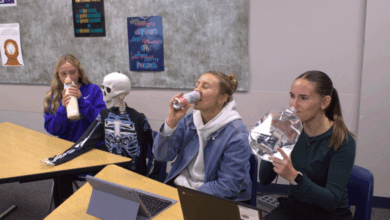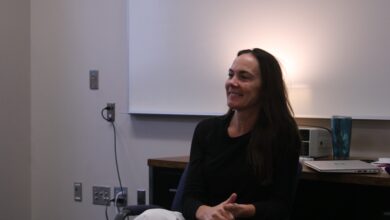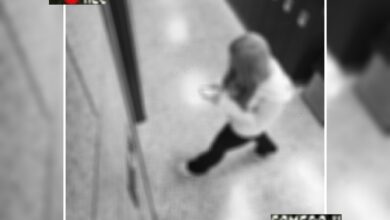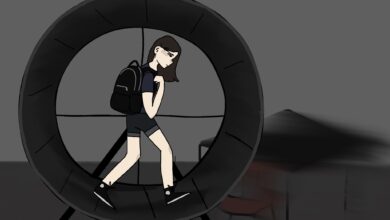
Imagine that one day, you’re minding your business and notice people staring at you. You check if there’s anything on your shirt or something in your teeth. There isn’t. The staring doesn’t stop, but worsens from silent whispers, laughs, and stink eyes being thrown your way too. There’s nothing wrong with you, but the real reason this is happening is your skin color. That’s a normal day for black women in a Predominantly White Institution (PWI).
“The mind of a black woman” is a rare topic of conversation. What it may be like for them in environments where they aren’t welcome is equally as uncommon. Many African American women talk and think about it, but it’s more silenced than understood in our society. What is it like to be a black woman? Is it glamorous, with their perfect lips and hips that attract the eyes of horndogs, or is it lonely and full of hardships and insecurities?
LL* is an outstanding student at Buffalo High School. In her years of high school, she has accomplished many things and she is full of ideas, including big plans for her future. She’s been in music classes since she was young and she’s been an honor student from the moment she started school. Even with her high status, cool friends, and good grades, she still experiences the mistreatment of being a woman of color.
“At the beginning of the year, when I was still taking the bus, there were these middle schoolers,” LL said. “Basically, they were dehumanizing black women talking about ‘oh BBW’s, their tits this, their body that.’ All the stuff they wanted to do to them. They were saying the n-word and stuff too. I was just like, ‘Wow! You’re literally in middle school, pipe down.’ This energy, it starts young. I think that’s what showed me that racism is taught early. [Those kids were] so young and they were already exhibiting this behavior.”
LL gets into depth about racism that mostly occurs on the bus. She says that the bus is a place where kids feel the freedom and the need to express themselves without being monitored by a teacher or staff. Racism is a common practice on the bus. Most of the time, the bus driver doesn’t say or do anything to stop it.
“I’ve been [in Buffalo] long enough that people shouldn’t [treat me] differently because I’ve been cool with a lot of people from different groups and backgrounds,” LL said, “but sometimes they still treat me differently. It’s gotten a little bit better since I’ve grown up, but it was worse in elementary school. Even now in high school, I see a lot more people that look like me.”
Principal Mark Mischke says that Buffalo High School has been taking intentional steps over the last few school years to ensure that the school is a safe place – physically and emotionally – for People of Color (POC).
“Every kid should see themselves in our building,” said Principal Mark Mischke. “Regardless of their race as they come in, they should be able to see themselves in our building and feel comfortable here, and not be exposed to negative, negative, slanderous comments being made to them.”
Much of the racism that POC experience, however, can come outside of the walls of the school. Unfortunately, it’s not just on the bus where these things happen. On social media among teens, there are many racist and homophobic things said on those flashing phone screens. The freedom teens are granted online can be truly abused, and an issue that black women seem to face more often than not is being stereotyped and being called harsh names.
“I don’t think anybody deserves it,” LL said. “I don’t think… I hope I don’t deserve it, and I feel like I can recover. It’s high school, and everybody’s going to grow up. If you peak with this energy, then good for you, that’s what you deserve, but I don’t think it fazed me too deeply because I grew up and realized that people that look like me, are going through this too. My biggest [issue] was when George Floyd died and everybody’s perspectives suddenly changed. Like now, now is when you wanna change? You had all these years [to change]. There’s not a time for enlightenment. You should have always known that we’re human beings, and it shouldn’t take someone dying for you to understand that.”
Frenzy* is another student of color that goes to Buffalo High School. In the past and present, she has dealt with the hardships of being discriminated against as a student because of anything from her braid style to how well-spoken she can be at school. She’s seen and heard the truth of what really happens at this high school.
“[Even] a couple of days ago, I was minding my business and I could feel that people were treating me a certain way just because I was black,” Frenzy said. “Nothing major, but it’s just disheartening because you have done nothing, and you don’t deserve that, but you still feel that judgment from people.”
Buffalo High School is a PWI. According to US News and World Report, About 90% of BHS students are White, 4% of students are Hispanic, 3% of students are two or more races, 2% of students are Black, and 1% of students are Asian.
“Over the last three years, we’ve done training of our entire district staff,” Mischke said, “and we are continuing to take steps and move forward in terms of preparing a more well prepared staff to be able to work through [racial] situations both proactively and reactively. We’ll continue to move forward on that because we have a lot of work yet to do.”
Even though some progress appears to have been made, racism remains an issue for POC in this region of the U.S.
“I feel like I’ve grown from the bad things that have happened to me or the environment that I’m in, but it also has caused me to question myself a lot,” Frenzy said. “It’s caused a lot of self-doubt within me. I feel like we don’t get any or just the same opportunities as everyone else, and they don’t have to try as hard as we do to just get to the same level.”
A black woman’s story isn’t too distant to understand. Their experiences are shared worldwide through a number of platforms, some of the most common being TikTok and Instagram. The shared trauma among PWI survivors is spoken about clearly so that others don’t feel so alone about being the rejected black woman.
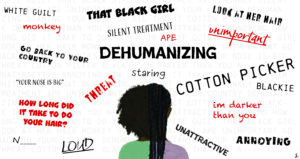
“I feel like there’s a lot of different [reasons why],” Frenzy said. “There’s people whose parents are just like them, and they’re also racist so that’s all they know and all they’ve learned, but that’s not an excuse. There’s the people who just learn that from being [around] people who also think that way so they’ve just adapted that way, and then there’s the people who just hate black people.”
There are countless untold stories that go back tens of years, to even before the current building was built [in 1997]. Behind the velvet and brown brick walls, there has been and still is much mistreatment and issues caused by the severe racism that is experienced by black students here. The ignorance that has been allowed to continue for generations still happens today, causing trauma and problems for POC that don’t deserve it, and it all starts at a very young age.
The dirty looks and stares, name calling, derogatory terms, fake pity, sexualization, covered trauma, being the last picked, racist jokes yelled across the room, gagging sounds being made at you, and being treated like entertainment if you’re even noticed at all are all examples of racially motivated bullying and being seen as “less than.” Frenzy, LL and other POC have heard things like “that blackie,” generalizations about “black people,” fellow students stating “I will pay you to say the n-word,” or whispers of “look at her hair.” These are things black children become used to hearing in school from early ages in a PWI, regardless of the changes that an institution may make.
This article truly represents a very small percentage of this issue around PWIs and the painful experiences that happen to POC, especially black women. When children are only sent to school to make friends and get an education, shouldn’t school be a good experience for everyone? I know there are many opinions on this article already forming in your mind. You’re wondering why it matters, debating if you want to protest, or sending evil thoughts my way, but really question yourself and think if you want to waste your time being part of the problem.
* Due to the sensitive nature of the story, names have been changed to protect students.
Illustrations by Amelia Butler
For the rest that’s unsaid, here’s a poem written by a student in 2021.
My poem.
I feel like I’m screaming
Yet my mouth doesn’t move
I just want to cry
The day will be over soon
The sight of my skin to another
Is far from a ten
anxiety is tangled
Inside my head
They seem not to like me
Even if I try
I’m the elephant in the room
My feet feel tied
I desire to be accepted
But I’m far from their standards
Yet my lips are a trend
And my hips are highly favored
My heart gets broken
Every afternoon
I’m far from their perfect
They see me as a fool
The comments and insults
Never come to an end
Someone’s ignorance
stays loud in my head
My strength can only last so long
But until then
I’ll have to be strong.
My curls
My body
My skin
My nose
The evil in others completely shows
I’m not a threat
But my breathing is dangerous
To someone close-minded
I’m black.

